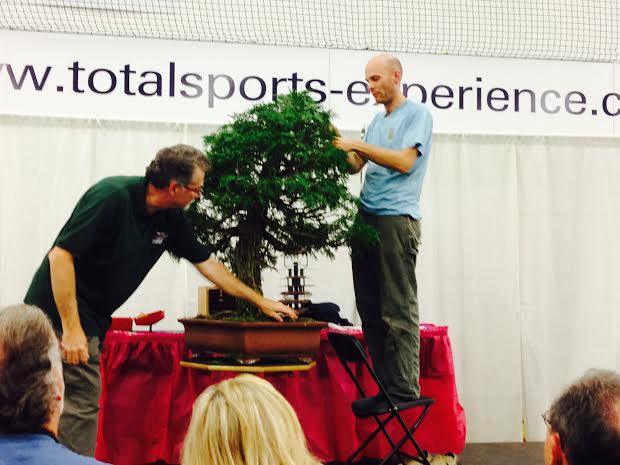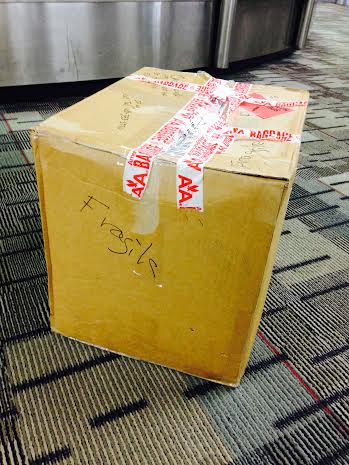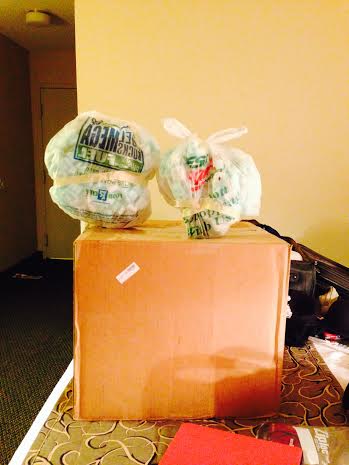by Carol Novak
Much as I enjoy the wonderful trees our club members show every year at the fair, I had never seen an entire show of the level I have seen when I pored over in books, magazines and on the internet. I had heard of the National Bonsai Exhibition, but I never thought of attending until Nancy Chipps mentioned that Cheryl Sykora was going to have a tree in the exhibition and with infectious enthusiasm, that she was going. I heard also that they would have great vendors, and I was eager to find stands and fresh material. As Cheryl pointed out, trees grown in New York are those likely to do well in Minnesota, and I might do better to get trees there than at the upcoming GSBF. So off I went with a carry-on suitcase and a box full of styrofoam peanuts to out-state New York with a plan to buy one perfect tree. I was asked to write an article for the newsletter and am finishing it while sitting at the gate on my return flight home while they fix the plane door latch. (Wouldn’t want a broken door.)
On arrival in Rochester, I took a quick shuttle to an unprepossessing hotel and met up with Nancy, and we went out for a delicious meal at a Brazilian restaurant. The next morning, after our typically bad co-navigation, we arrived at the Total Sports Experience for a sporting bonsai competition.
I chose to visit the vendor floor first so as to look at trees before they were too picked over. Not only were there hundreds of pots, but the pot makers themselves. Nancy stopped to chat with Sara Rayner and I enjoyed meeting the couple that makes MC 2, whose pots I’ve admired on the Internet. I picked up accent pots by each of them. Jim Gremel sold me two pots for a reasonable price bearing his signature swirls and thumb prints. The stands, both antique and contemporary, were marvelous. Unfortunately they are too expensive to collect on the off chance I might ever need one to show a bonsai of any particular size. The exception I made was a sweet, medium-height shohin stand with a burl inlay that Bjorn BjorhoIm brought back from Japan. In between visits to the stands, we took in demonstrations by Alice Chen on calligraphy and creating bonsai from nursery stock by Hiroyoshi Yamaji from Japan.

When I was finally ready for the exhibit and the crowd had thinned, I left the astro turf of the vendor area for the spectacular set-up next door. I was awestruck by many of the trees. While nothing stood out as new, unusual and creative; the style, form and attention to detail was often exquisite. There were trees by some of the rock stars of bonsai such as Suthin Sukosolvisit, Owen Reich, Bjorn Bjorholm, Jim Doyle, and Colin Lewis, all of whom were in attendance. Boon Manakitivipart himself was present but few trees from the west coast were brought out, presumably due to the lengthy travel back and forth. Suthin showed a finely styled mugo pine in a position of honor at the end cap of a row in… drum roll… a pot he commissioned from our own Nancy Chipps, which sat on an antique Asian stand. The pot had real chemistry with the tree, connected by exquisitely placed moss, and showed the mugo off at its finest. Cheryl showed two impressive trees; a flowering apricot and a Ponderosa pine offset by a tiny, delicate grape accent. All Pots and trees will be memorialized in the 2014 Commemorative Exhibition Album. Photographs of the exhibition were not allowed and members of MBS will need to wait to see it.
That evening Cheryl, Bill, Nancy and I attended the awards banquet and benefit auction. David Easterbrook, Susumu Nakamura and Peter Warren were the judges. After a somewhat lengthy series of thank-you scrolls were handed out, the judges announced the prize winners. Suthin’s mugo might have taken the main prize, perhaps, if his stately elm hadn’t won best in show. A new prize was invented by the judges – none of whom are from the U.S. – called the “All American Award”. This was awarded to the best display of a native tree, in an American-made pot and stand.
The next day Bill and Cheryl drove us over to Hollow Creek Nursery where we roamed overgrown rows of a variety of trees, with an especially large selection of maples. I picked up a Chinese quince and an interesting Chinese elm. Cheryl found two large ficus to add to her trunk-full of finds from the vendors at the show. We then headed over to Bill Valavanis’ home to view his private collection. He unexpectedly had young trees for sale there, and after seeing porcelain berries for the first time, I couldn’t resist picking up a seedling of the variegated variety.
We headed back to the show to catch Peter Warren demonstrating refining a Eastern White Cedar that Marc Noelanders originally designed years ago. He explained that the Japanese are more fond of structured trees such an pine and junipers. He answered questions such as “when will this tree need to be re-potted?” with great discussions about how the “book wisdom” is that trees should be repotted every year or two is simply wrong. Trees should stay in the pot as long as possible without getting pot-bound or have trouble absorbing water. My mind went off to how much time and soil I am going to save from now on! Cheryl and I got rowdy and called out our opinion that a certain major branch should go.

Peter Warren re-styling an Eastern White Cedar to be auctioned off at the end of the demonstration. One new thing I learned is that the biggest cause for branch failure on junipers and certain other conifers after wiring is twisting the branches. Although their branches can be bent up and down, side to side and even coiled like pretzels, twisting them along their length too far breaks the line vein. The most important hand while wiring is the supporting hand (usually the left) used to prevent the branch from twisting and hold foliage aside. He noted that some people switch hands to use their dominant hand in the supporting role because of that. I felt quite smug to realize that, while left handed, I can wire ambidextrously using whichever hand is convenient to the direction of the branch.
Two trees that didn’t make it into the box, in bags stuffed with styrofoam; ready for the rigors of being squashed in the overhead bin. I never found one, medium-sized, perfect tree. Perhaps it was sticker shock. Nothing was ever going to be “the one”, which it would have had to be for me to spend over $300. Instead, I found about a dozen adorable shohin and mame sized trees. It is probably just as well given that as a novice my horticultural success rate isn’t quite there yet. All but two of them fit like a Chinese puzzle in the box using shrink wrap and peanuts.
They announced that the door is fixed. Now I can think about how I’ll unpack the peanuts without making a mess, and guess the amount of eye-rolling my husband will do when he watches me hopelessly trying to squeeze a dozen new trees on my crowded benches.

Postscript: I wish I could say my trees made it reasonably safely home. Apparently, the TSA agents got very suspicious, dug vigorously down to the bottom of the box tearing two quinces off one tree along with many of its branches, until they got to their “prize” – a beautifully wired natal fig. They tried to – I kid you not – take the wire off the branches! After failing to do more than break the main character and other important branches, they left me their inspection tag tucked in amongst the tangle. The moral of the story is, if you pack trees on the plane in a box, don’t have wire on them. Not everyone can tell a bonsai from a bomb.
